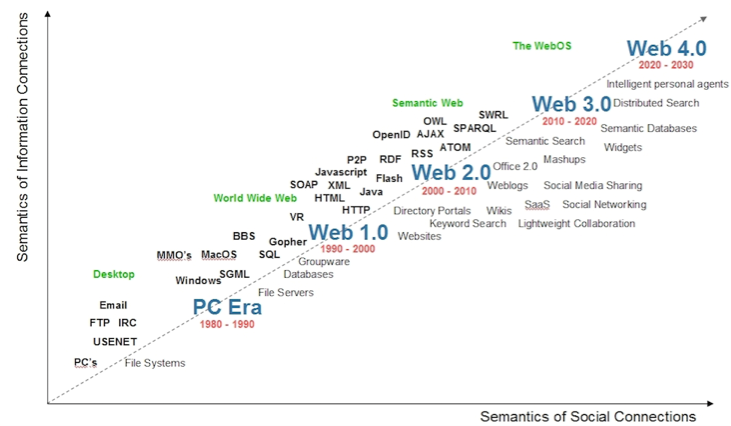The evolution of web browsing from Web 2.0 to 4.0 has transformed online marketing. From a historical point Web 1.0 was the foundation interface for the World Wide Web, unfortunately it had a limited scope of use for online marketing, connectivity, and interaction and for this blog it truly only represents the starting point for the highly efficient, adaptive, and evolving platforms of Web 2.0, Web 3.0. Currently, online marketing services use Web 3.0. Web marketing has pioneering the way we interact with business and how that business interacts with us. Like anything digital we can only assume that the transition from Web 3.0 to Web 4.0 will only improve responsiveness, adaptation, and interaction that digital generations are highly anticipating.
Evolution of the Web (Spivack, N, 2007).

Web 2.0 (2000 – 2010)
The evolution of the Web 2.0 pioneered interaction and adaptation of web content for digital marketing firms, more so through social media but it created the platform for E-commerce (Mata and Quesada, 2014). It scope included
- Free for use content
- Ad-supported interfaces
- Networking and Blogging
- Video content
- Data exchange
Web 2.0 encouraged social connectivity and relationships through user-generated content, it crafted social networks that ultimately linked e-commerce with social media (Chaffey and Ellis-Chadwick, pg. 36, 2016). However Mata and Quesada (2014) concluded it was simply the evolution of social interactions, but as it evolved became the platform for marketing by promoting businesses, and eventually e-commerce.
Web 3.0 (2010 – 2020)
Coined the future Semantic Web, created by Tim Berners-Lee, a highly intuitive and responsive exchange that has revolutionised marketing. Wiley (2010) summarises the capabilities as key ingredients for marketing
- Personalisation
- Mobile interface
- Video streaming
- Microblogging
Semantic Web essential means a web of data easily processed and analysed by Operating Systems (OS). It allows users to process complex information and perform tasks in a highly efficient manner (Chaffey and Ellis-Chadwick, pg. 37, 2016). This technology will support a smooth transition into Web 4.0 and already allows e-commerce to sample some of the benefits Semantic Databases will have in the future for marketing and e-business through collaboration, networking and intuitive interfacing.
Web 4.0 (2020 – 2030)
The future of Web marketing is exciting, fascinating, and frightening as the technology will allow more connections, more assumptions, and even more analysis of an individual’s wants and needs. I have been unable to establish a sound definition of Web 4.0 however, like the future of Web technology we can make assumptions of its power and capabilities
- Intelligent interactions
- Initiative marketing
- Strategic assumptions
Touted as having the ability of Artificial Intelligence (AI) to take initiative on behalf of that user to make assumptions based on their preferences, search history, and input. The ability to make strategic assumptions, for example if you are booked on a flight that has been delayed or cancelled not only will the interface search for alternative means of travel but it will inform those you may have been scheduled to meet with that you will now be late (Wiley, 2010).
From a marketing perspective the evolution of the Web has introduced a new way to market online, it has adapted to global trends, wants, and needs and throughout its journey evolved as we as society have evolved. Not only can we access and navigate through web data quicker and easier but our search history is allowing operating systems to make assumptions and directing us on our behalf, which from a marking perspective is a huge advancement.
References
Chaffey, D. and Ellis-Chadwick, F. (2016). Digital Marketing: Strategy, implementation and practice. Edinburgh Gate: Pearson Education Limited
Mata, FJ, & Quesada, A 2014, ‘Web 2.0, Social Networks and E-commerce as Marketing Tools’, Journal of Theoretical & Applied Electronic Commerce Research, vol. 9, no. 1, pp. 56-69.
Wiley, DL 2010, ‘Marketing in the Moment: The Practical Guide to Using Web 3.0 Marketing to Reach Your Customers First’, Online, vol. 34, no. 6, pp. 62-63.
Spivack, N. (2007). Evolution of the Web. Available at http://novaspivack.typepad.com/RadarNetworksTowardsAWebOS.jpg [accessed 28 August 2016].